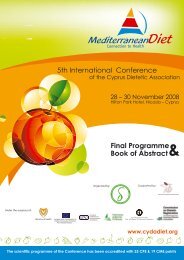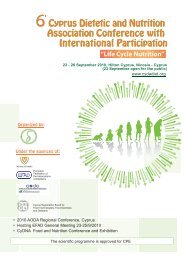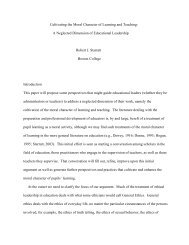Create successful ePaper yourself
Turn your PDF publications into a flip-book with our unique Google optimized e-Paper software.
THE USE OF SYNTHETIC COLORS (E102, E104, E110, E122,<br />
E124, , E129) ) AND OF THE PRESERVATIVE SODIUM<br />
BENZOATE IN FOOD AND DRINKS CONSUMED BY<br />
CHILDREN IN CYPRUS<br />
E. <strong>Ioannou</strong>‐<strong>Kakouri</strong>, E. Procopiou, A. Krashia, M. Frantzi<br />
State General Laboratory (SGL), 44 Kimonos, Nicosia‐Cyprus<br />
Ministry of Health<br />
www.moh.gov.cy<br />
www.moh.gov.cy/sgl<br />
o go cy cy/sg /sgl /sg<br />
6th Cyprus Dietetic and Nutrition Association Conference<br />
with International Participation “Life Life Cycle Nutrition Nutrition”, ,<br />
23‐26 September 2010, Hilton Cyprus Hotel, Nicosia –Cyprus
Introduction<br />
• The incidence and the levels of several food<br />
additives (colours, preservatives, synthetic<br />
sweeteners etc) in locally produced and imported<br />
foodstuffs are monitored and controlled<br />
systematically by the State General Laboratory<br />
(SGL) since 1980s.<br />
• Special emphasis is given to synthetic colours and<br />
preservatives used in foods and drinks consumed by<br />
children.
• The monitoring and control is performed according to the<br />
requirements of relevant relevant EU legislation (Reg. No. 1333/2008<br />
etc).<br />
• SGL is the Official Control Laboratory y and the National<br />
Reference Laboratory of Cyprus, in many fields of food<br />
safety and cooperates with the Health Services of the<br />
Ministry of Health for sampling and enforcement.<br />
• Furthermore SGL participates in Expert Committees and<br />
WWorking ki GGroups of f EEuropean CCommission i i (EC) and d EEuropean<br />
Food Safety Authority( EFSA).
Reason for this study<br />
• ArelevantsurveyoftheUniversity of Southampton<br />
(McCann ( et al, 2007. The Lancet, 6 Sept. p 2007) )<br />
whose subject was the correlation of the synthetic<br />
food colours E102, E104, E110, E122, E124, E129<br />
and the preservative sodium benzoate with<br />
hyperactivity yp y in children.<br />
• Duetothis,theMinistryofHealth(MoH) fundeda<br />
study (2008‐2009) (2008 2009) carried out by the SGL with the<br />
aim:
Aim of the study<br />
• The investigation of the real/analytical levels of the six colors<br />
(Ε102, Ε104, Ε110, Ε122, Ε124, Ε129) and the preservative<br />
sodium benzoate (Ε211) in ice‐cream ice‐cream, drinks drinks, fruit drinks drinks,<br />
candies, snacks, desserts, tomato ketchup and other foodstuffs<br />
consumed by children in Cyprus.<br />
• Collection of data and evaluation of the status of these<br />
foodstuffs in Cyprus, for use in the consultative diet policy of<br />
the Ministry of Health to parents and other stakeholders.<br />
• DDevelopment l off amethod h d off quantifying if i synthetic h i colours l iin<br />
several types of food and drinks.<br />
In the present study a total number of 369 samples were<br />
examined !
Results Results‐ No and % of positive samples<br />
Α/Α Food or Drinks Synthetic colors Southampton<br />
(E102, E104, E110, E122,<br />
E124, E129)<br />
Number of % of positive<br />
samples<br />
(1<br />
samples<br />
st phase/2nd phase)<br />
Sodium benzoate (Ε211)<br />
Number of<br />
samples<br />
(1st phase/2nd phase)<br />
% of positive<br />
samples<br />
1 Ice creams 63 / 41 31 ‐ ‐<br />
2 Drinks 59 / 33 33 57/20 42<br />
3 Fruit drinks 11 / 14 16 10 / ‐ 0<br />
4 Gel 15 / 19 74 ‐ ‐<br />
5 Candies/<br />
Lollipops/ Chewing gums<br />
42 / 38 65 ‐ ‐<br />
6 Ketchup 11 / ‐ 0 11 / ‐ 27<br />
7 Snacks 16 / ‐ 0 ‐ ‐<br />
8 Desserts with yoghurt for kids 7 / ‐ 0 ‐ ‐<br />
Total 224 / 145 78 / 20
samples<br />
% ppossitive<br />
30.0<br />
25.0<br />
20.0<br />
15.0<br />
10.0<br />
5.0<br />
0.0<br />
Ε102<br />
Ε104<br />
Ε110<br />
Ε122<br />
Ε124<br />
Confectionery<br />
(sweets, candies)<br />
Desserts<br />
Edible ices<br />
Soft drinks<br />
Fruit drinks<br />
Ε129<br />
Southampton Colours
Levels of Synthetic Colours in foodstuffs in Cyprus (2008‐2009)<br />
Colour<br />
Edible ices<br />
Confectionery<br />
(sweets (sweets, candies)<br />
Desserts Fruit drinks Soft drinks<br />
Mean value Mean value Mean value Mean value Mean value<br />
mg/kg g/ g mg/kg g/ g mg/kg g/ g mg/kg g/ g mg/kg g/ g<br />
E102 16,4 19,9 33,1 0,0 6,8<br />
E104 18,1 42,1 2,0 0,0 9,2<br />
E110 21,0 13 13,22 84 8,4 5,5 16 16,33<br />
E122 25,7 5,9 17,2 50,0 33,2<br />
E124 29,9 11,3 19,2 0,0 0,0<br />
E129 0,0 46,6 0,0 12,5 17,9
MMean<br />
valuee,<br />
mmg/kg<br />
or mgg/l<br />
50.0<br />
40.0<br />
30.0<br />
20.0<br />
10.0<br />
0.0<br />
E102<br />
E104<br />
E110<br />
E122<br />
SSouthampton th t Colours<br />
C l<br />
E124<br />
E129<br />
Φρουτοποτά<br />
Confectionery<br />
(sweets, candies)<br />
Desserts<br />
Soft drinks<br />
Edible ices
Discussion<br />
• 16‐74% 16 74% of the tested food groups were<br />
positive inthepresenceofoneormoreof<br />
the six colors and<br />
• 27‐42% of the food groups were positive for<br />
sodium sod u benzoate be oate<br />
• None of the six colors was identified in<br />
ketchup, snacks and desserts with yoghurt.
• Synthetic colours E102, E104, E110, E122, E124,<br />
E129 ( Southampton colours) and E131 & E133,<br />
were not identified in a significant percentage of<br />
the examined number of ice‐cream samples (65%).<br />
Συνθετικές<br />
χρωστικές<br />
Southampton<br />
(E102, E104, E110,<br />
E122, E124, E129)<br />
31%<br />
Συνθετικές<br />
χρωστικές (Ε131<br />
και Ε133)<br />
4%<br />
Φυσική χρωστική<br />
Ε120<br />
22%<br />
Δεν ανιχνεύθηκαν<br />
συνθετικές<br />
χρωστικές<br />
43%
• Th The simultaneous i lt presence off a synthetic th ti<br />
color and sodium benzoate was identified in<br />
22% of the soft drinks<br />
• With a simple risk assessment e.g. for sodium<br />
benzoate benzoate, one kid aged 22‐4 4 years old (15kg<br />
body weight), can receive 2/3 of the<br />
acceptable daily intake (ADI) (ADI), by consuming a<br />
can of soft drink (330ml) which contains a<br />
maximum limit quantity of sodium benzoate<br />
(150mg/l).
EFSA΄s EFSA s relevant work<br />
• The European Commission (EC) asked EFSA to consider these<br />
six colours. First EFSA opinion was in 2008 .<br />
• It was mentioned by EFSA that children who consume<br />
•<br />
intensively coloured candies and soft drinks, it is possible for<br />
some of the additives in the Southampton study, to reach<br />
their acceptable daily intake (ADI) (ADI).<br />
In the light of all new evidence, EFSA re‐evaluated the safety<br />
of the six colors and reduced the ADI for the three of them<br />
(EFSA opinion Nov. 2009) Quinoline Yellow (E104), Sunset<br />
Yellow FCF (E110) and Ponceau 4R (E124).<br />
• Generally, EFSA has the mandate to re‐evaluate all food<br />
additives which are allowed within E.U.( Reg.257/2010 set<br />
up a timeline for re‐evaluation of additives permitted before<br />
20 Jan.2009).
European Commission – SGL SGL‐EFSA EFSA<br />
• Furthermore, European Commission (EC) put in<br />
force a new Regulation for food additives (Reg. No.<br />
1333/2008) including mandatory additional labeling<br />
information for the presence of these six colours,<br />
that “they may have an adverse effect on activity<br />
and attention of children”.<br />
• The SGL participates actively in the Working Groups<br />
of EC on additives for drafting g the relevant<br />
legislation and other WG of EFSA.
• The results of study: y<br />
Use of results<br />
• will be used in the dietary advices of Min. of Health<br />
and other stakeholders for the reduction of intake/<br />
consumption of food containing to much synthetic<br />
food colors and other additives especially by<br />
children!<br />
• Will be sent to EFSA and European Commission( EC)<br />
within the spirit of networking and exchange of<br />
information between Member States of EU EU, EC and<br />
EFSA.
• Many thanks to:<br />
• The Min. of Health for funding the study<br />
• My co‐workers in SGL : EE. Procopiou Procopiou,<br />
A. Krashia, M. Frantzi<br />
• The organizers of the 6 h th CyDNA Conference





